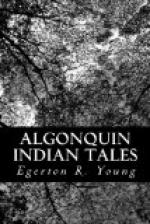“For a time Nanahboozhoo had to guard the now rapidly growing young world from the larger animals with a stick, for fear they would sink it. They were all very tired of having to remain huddled together so long on the raft, and were eager to follow the smaller creatures that seemed so happy on the new earth, even if it were not very large as yet. As there was much to be done to fit this new world up for them to dwell upon, everyone had to do what he could. The birds were sent to fly over the water to pick up branches and seeds.
“By and by Nanahboozhoo decided that the earth, which had now grown beyond the reach of his eyes, was large enough, and so he revived the otter, the beaver and the muskrat, and with them and all the other animals around him he took possession of the new world.
“In order to ascertain the size of the world he sent a wolf to run to the end of it and then to return at once to him. The wolf easily made the journey in one day. Nanahboozhoo then kept him with him for some time, and again sent him off. The second journey took him five days, the third ten, the fourth a month, then he was gone a year and then five years. Thus it went on, until at length Nanahboozhoo started off a young wolf just able to run on the long journey. This one died of old age ere he had completed the trip. Nanahboozhoo then said that the world was large enough, and commanded it to cease from growing.”
CHAPTER XIX.
Among the Briers and Wild Roses—Why the Roses have Thorns—Why the Wild Rabbits are White in Winter.
One day as the children were out in the clearings back of their home, gathering some of the wild strawberries that grew there and also some of the wildflowers that bloomed during the short brilliant summer, they were delighted to see Souwanas coming along the road with his gun on his shoulder and some ducks and rabbits in his hand.




